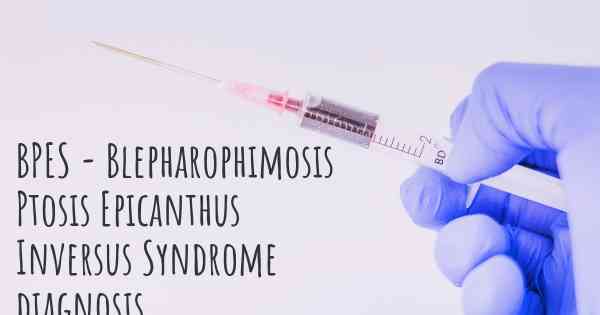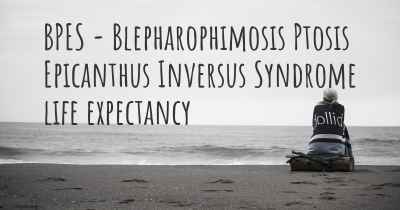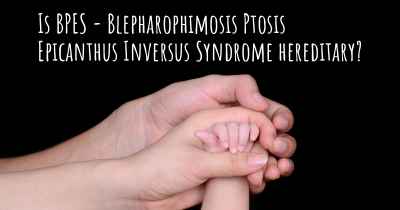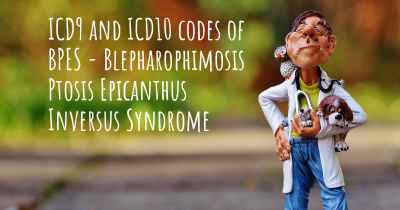How is BPES - Blepharophimosis Ptosis Epicanthus Inversus Syndrome diagnosed?
See how BPES - Blepharophimosis Ptosis Epicanthus Inversus Syndrome is diagnosed. Which specialists are essential to meet, what tests are needed and other useful information for the diagnosis of BPES - Blepharophimosis Ptosis Epicanthus Inversus Syndrome

Diagnosis of BPES - Blepharophimosis Ptosis Epicanthus Inversus Syndrome
Blepharophimosis Ptosis Epicanthus Inversus Syndrome (BPES) is a rare genetic disorder that affects the development of the eyelids and other facial features. It is characterized by a combination of blepharophimosis (narrowing of the eyelid openings), ptosis (drooping of the upper eyelids), epicanthus inversus (an upward fold of skin on the inner corner of the eyes), and telecanthus (increased distance between the inner corners of the eyes).
Diagnosing BPES involves a comprehensive evaluation of the individual's clinical features, family history, and genetic testing. The process typically involves the following steps:
Clinical Evaluation
The first step in diagnosing BPES is a thorough clinical evaluation by a healthcare professional, usually an ophthalmologist or a geneticist. The doctor will examine the individual's facial features, focusing on the eyelids, inner corners of the eyes, and other associated abnormalities. They will also assess the degree of eyelid narrowing, drooping, and the distance between the inner corners of the eyes.
Key clinical features that may indicate BPES include:
- Blepharophimosis: Narrowing of the eyelid openings
- Ptosis: Drooping of the upper eyelids
- Epicanthus inversus: Upward fold of skin on the inner corner of the eyes
- Telecanthus: Increased distance between the inner corners of the eyes
Family History
BPES is often inherited in an autosomal dominant manner, which means that an affected individual has a 50% chance of passing the condition on to each of their children. Therefore, obtaining a detailed family history is crucial in diagnosing BPES. The doctor will inquire about any family members who may have similar eyelid abnormalities or other associated features.
Important questions to ask regarding family history include:
- Are there any family members with similar eyelid abnormalities?
- Have any family members been diagnosed with BPES or other related genetic disorders?
Genetic Testing
Genetic testing plays a vital role in confirming the diagnosis of BPES and identifying the specific genetic mutation responsible for the condition. The most common genetic cause of BPES is a mutation in the FOXL2 gene, located on chromosome 3q23. Genetic testing can be performed using various techniques, such as DNA sequencing or targeted mutation analysis.
The steps involved in genetic testing for BPES include:
- Collection of a blood or saliva sample from the affected individual
- Isolation of DNA from the sample
- Sequencing or targeted analysis of the FOXL2 gene
- Comparison of the obtained genetic data with known mutations associated with BPES
If a mutation in the FOXL2 gene is identified, it confirms the diagnosis of BPES. However, in some cases, genetic testing may not reveal any mutations, especially in individuals with atypical or milder forms of the syndrome.
Additional Evaluations
In some cases, additional evaluations may be necessary to assess the extent of the syndrome and associated abnormalities. These evaluations may include:
- Visual acuity testing: To evaluate any potential vision problems
- Eye movement testing: To assess any abnormalities in eye coordination
- Referral to a genetic counselor: To provide information and support regarding the genetic implications of BPES
It is important to note that the diagnosis of BPES should be made by a qualified healthcare professional based on a combination of clinical evaluation and genetic testing.
Once a diagnosis of BPES is confirmed, appropriate management and treatment strategies can be implemented. These may include surgical interventions to correct eyelid abnormalities, vision therapy, and ongoing monitoring of associated health issues.








